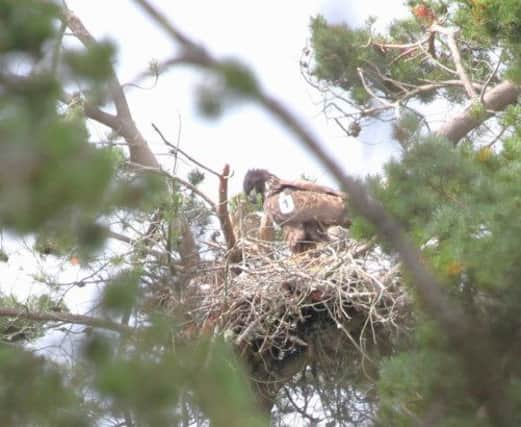Rare white-tailed eagle raised in east of Scotland


A pair of white tailed sea eagles have raised and fledged a single chick at a secret nest site in Fife in a historic milestone for conservation - four years after being released into the wild as part of a major scheme to reintroduce the massive bird - dubbed “flying barn doors” - to the east of the country.
The last native British white-tailed eagle was shot in Shetland in 1918. And last August, the last six of 85 young sea eagles, taken from nests in Norway, were released into the wild at a secret location in Fife, marking the culmination of the programme to re-establish a white tailed eagle population on the eastern mainland being spearheaded by RSPB Scotland, Scottish Natural Heritage and Forestry Commission Scotland,
Advertisement
Hide AdAdvertisement
Hide AdThe location of the nest site where the male chick was successfully reared by the pair of four year-old birds of prey is being kept a closely guarded secret. Conservationists would only reveal today that the chick had fledged in a Forestry Commission Scotland wood somewhere Fife where its progress is continuing to be regularly monitored by project staff and volunteers.
Paul Wheelhouse, Scotland’s Minister for Environment and Climate Change, said: “This is fantastic news – it is the first chick in almost two hundred years to be hatched on the mainland of the east coast, which was the ultimate aim of the reintroduction project. I hope it will be the first of many of this magnificent species which will eventually spread their territories right across Scotland. I’d like to thank all partners who have played their part in making this exciting and special event happen.”
Stuart Housden, the director of RSPB Scotland, said: “This chick marks a huge milestone in our partnership to restore white-tailed eagles to their former range in the south and east of the country. This success further strengthens the strong bond we have formed with the people of Norway, who kindly gifted birds for release in Scotland throughout the reintroduction process, which started over 30 years ago on the West coast.
“Young birds successfully released 5-6 years ago are now pairing up in the wild-and we are very excited a chick from a nest in Fife has safely fledged. We owe a great deal to the project staff, farmers, landowners, partners and of course the general public for their support and enthusiasm. Our focus now will be to continue monitoring this youngster and the other east coast birds with the expectation of more breeding attempts next year. These wonderful birds are back! “
Ron Macdonald, SNH’s Head of Policy and Advice, said it was a landmark for conservation is Scotland. He said: “After almost 200 years, it’s wonderful to have a sea eagle chick fledge again in the east of Scotland. With the west coast eagles already established, this is a good step towards a healthy population of sea eagles across the country.”
The £452,000 reintroduction programme has been partly funded by the Heritage Lottery Fund. And Colin McLean, Head of the Heritage Lottery Fund, Scotland, said: “The arrival of this chick marks the beginning of a new era for the sea eagles in the east coast of Scotland. The Heritage Lottery Fund is delighted to be involved in reversing the fate of these rare, once native, birds. They are part of Scotland’s natural heritage and it is the prospect of glimpsing rare species, such as the glorious sea eagle, that attracts visitors to our shores bringing much-needed tourist income to our communities.”
A spokesman for the RSPB said: “Having found a safe and secure home, the adult pair successfully reared a healthy male chick which was fitted with a leg ring and white wing tags with black numbering, earlier this summer by trained and licensed ringing experts.”
He explained: “The East Scotland Sea Eagle project is the third phase of the Scottish sea eagle reintroduction, which began on Rum in 1975. Over the next ten years to 1985 a total of 82 eaglets were imported, under special licence, from nests in northern Norway where the sea eagle population was still expanding. The second phase saw a further 58 birds released in Wester Ross between 1993 and 1998.”
Advertisement
Hide AdAdvertisement
Hide AdEarlier this year the reintroduction programme suffered a major blow when one of the first ea eagle nests to be built in the east of Scotland was destroyed. An investigation was launched after RSPB Scotland reported that a tree in which the pair of white-tailed eagles had made their nest on a remote estate in the Angus glens had allegedly been felled in January.
The sea eagle, or white-tailed eagle, is the biggest bird of prey in Europe. Numbers plummeted in the 19th century through a combination of widespread poisoning and shooting by gamekeepers and the actions of egg collectors. By 1918, the birds had been wiped out in Scotland.
SEE ALSO: